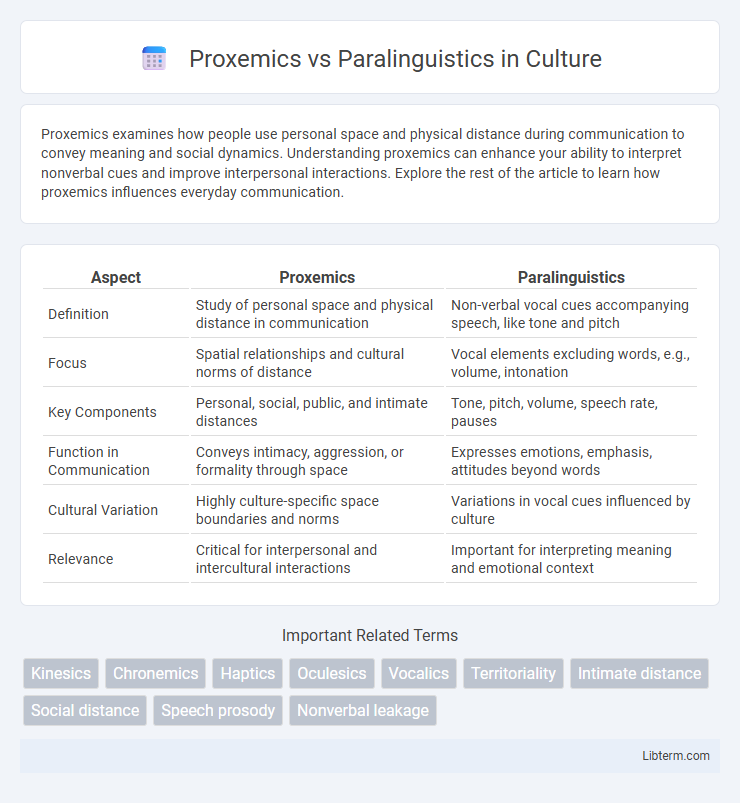Proxemics examines how people use personal space and physical distance during communication to convey meaning and social dynamics. Understanding proxemics can enhance your ability to interpret nonverbal cues and improve interpersonal interactions. Explore the rest of the article to learn how proxemics influences everyday communication.
Table of Comparison
| Aspect | Proxemics | Paralinguistics |
|---|---|---|
| Definition | Study of personal space and physical distance in communication | Non-verbal vocal cues accompanying speech, like tone and pitch |
| Focus | Spatial relationships and cultural norms of distance | Vocal elements excluding words, e.g., volume, intonation |
| Key Components | Personal, social, public, and intimate distances | Tone, pitch, volume, speech rate, pauses |
| Function in Communication | Conveys intimacy, aggression, or formality through space | Expresses emotions, emphasis, attitudes beyond words |
| Cultural Variation | Highly culture-specific space boundaries and norms | Variations in vocal cues influenced by culture |
| Relevance | Critical for interpersonal and intercultural interactions | Important for interpreting meaning and emotional context |
Introduction to Nonverbal Communication
Nonverbal communication includes proxemics, which studies the use of personal space and physical distance in interactions, and paralinguistics, involving vocal elements like tone, pitch, and volume that accompany speech. Proxemics reveals social relationships and cultural norms through spatial behavior, while paralinguistics conveys emotions and attitudes beyond verbal content. Together, these elements enhance the understanding of messages by adding context and emotional depth in human communication.
Defining Proxemics: The Language of Space
Proxemics studies how humans use space to communicate, interpreting personal distance, physical boundaries, and spatial arrangements as meaningful signals in social interactions. This field examines intimate, personal, social, and public distances to understand nonverbal communication influenced by cultural and situational contexts. Unlike paralinguistics, which focuses on vocal elements like tone and pitch, proxemics centers on the physical environment and spatial relationships to convey messages.
Understanding Paralinguistics: Beyond Spoken Words
Paralinguistics encompasses vocal elements such as tone, pitch, volume, and speech rate, which convey emotions and intentions beyond the literal meaning of words. It plays a crucial role in communication by providing context and nuance that influence interpretation and social interaction. Understanding paralinguistics enhances effective communication and helps decode underlying messages that are not explicitly stated through spoken language.
Key Differences Between Proxemics and Paralinguistics
Proxemics studies the use of physical space and distance in communication, focusing on how personal zones and spatial arrangements affect interactions. Paralinguistics examines vocal elements beyond verbal language, such as tone, pitch, volume, and pauses, which convey emotions and attitudes. The key difference lies in proxemics analyzing spatial behavior, while paralinguistics concentrates on vocal signals that modify or complement spoken words.
Cultural Variations in Proxemics and Paralinguistics
Cultural variations in proxemics significantly influence personal space preferences, with cultures like Japan favoring larger interpersonal distances compared to the close proximity common in Latin American countries. Paralinguistic elements such as tone, pitch, and speech tempo also vary widely, where, for example, Middle Eastern cultures often use more expressive vocal modulation compared to the more monotone delivery in Scandinavian countries. These differences in nonverbal communication underscore the importance of understanding cultural context to avoid misinterpretation in cross-cultural interactions.
The Impact of Proxemics on Social Interactions
Proxemics, the study of personal space and physical distance in communication, significantly shapes social interactions by influencing comfort levels and perceptions of intimacy or dominance. Variations in proxemic behavior across cultures affect how individuals interpret social cues and respond to others, impacting relationship dynamics and conflict resolution. Understanding proxemics enhances effective communication by facilitating appropriate spatial behavior that aligns with social contexts and cultural norms.
The Role of Paralinguistics in Conveying Emotions
Paralinguistics plays a crucial role in conveying emotions through vocal cues such as tone, pitch, volume, and speech rate, which communicate feelings beyond the spoken words. Unlike proxemics, which involves physical distance and spatial behavior to express emotions and social intentions, paralinguistics directly influences how emotional states are perceived in verbal communication. Research highlights that variations in paralinguistic features can significantly impact listener interpretation of emotions like anger, sadness, happiness, or sarcasm.
Misinterpretations and Communication Barriers
Proxemics, the study of personal space and physical distance, often leads to misinterpretations when cultural norms about acceptable proximity differ, causing discomfort or perceived aggression. Paralinguistics involves vocal elements like tone, pitch, and volume that can create communication barriers when these cues are misunderstood, leading to incorrect assumptions about emotions or intent. Both proxemics and paralinguistics play crucial roles in nonverbal communication, and misreading either can significantly disrupt message clarity and interpersonal understanding.
Integrating Proxemics and Paralinguistics for Effective Communication
Integrating proxemics and paralinguistics enhances communication by combining spatial behavior with vocal nuances to convey meaning more accurately. Proxemics involves the use of personal space and physical distance, while paralinguistics encompasses tone, pitch, and volume of voice. Effective communicators utilize both aspects to interpret emotions, regulate interactions, and build rapport in diverse social and professional settings.
Conclusion: Enhancing Communication Awareness
Proxemics and paralinguistics both play crucial roles in enhancing communication awareness by providing nonverbal cues that complement spoken language. Understanding spatial behavior, such as personal distance, alongside vocal elements like tone and pitch, allows individuals to interpret messages more accurately and respond appropriately. Integrating these aspects improves interpersonal effectiveness, reduces misunderstandings, and fosters stronger connections in diverse social and professional contexts.
Proxemics Infographic

 libterm.com
libterm.com